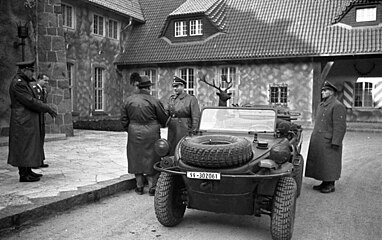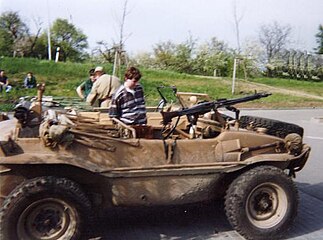Volkswagen Schwimmwagen
| Volkswagen Type 166 Schwimmwagen | |
|---|---|
 | |
| Type | Amphibious transport |
| Place of origin | Germany |
| Production history | |
| Manufacturer | Volkswagen |
| No. built | 15,584 (1942–1944) 14,276 at Fallersleben 1,308 by Porsche |
| Specifications | |
| Mass | 910 kg (1,345 kg GVW) |
| Length | 3.825 m (12 ft 6.6 in) |
| Width | 1.48 m (4 ft 10 in) |
| Height | 1.615 m (5 ft 3.6 in) |
| Engine | 4-cyl. boxer, air cooled 1,131 cc 25 hp @ 3,000 rpm |
| Transmission | 4-speed manual 2-speed transfer case; 4WD only on 1st gear or reverse |
The Volkswagen Schwimmwagen (literally "swimming car") is a light four-wheel drive amphibious car, used extensively by German ground forces during the Second World War. With over 15,000 units built, the Schwimmwagen is the most-produced amphibious car in history.[1]
Prototyped as the Type 128, it entered full-scale production as the Type 166 in 1941 for the Wehrmacht – Nazi Germany's military.
Development

The Porsche / Volkswagen Schwimmwagen used the engine and mechanicals of the VW Type 86 four-wheel drive prototype of the Kübelwagen, also used for the Type 87 four-wheel drive 'Kübel/KDF' Command Car (Kommandeurswagen), which in turn were based on those of the civilian KDF-Wagen. Erwin Komenda, Ferdinand Porsche's first car-body designer, was forced to develop an all-new unitized bodytub structure, since the flat floorpan chassis of the existing VW vehicles was unsuited to smooth movement through water. Komenda patented his ideas for the swimming car at the German Patent office.
The initial Schwimmwagen, Type 128 prototype, was based on the full-length Kübelwagen wheelbase of 2.40 m (7 ft 10 in). Pre-production units of the 128, fitted with custom welded bodytubs, demonstrated that this construction was too weak for off-road use. It had insufficient torsional rigidity, and easily suffered hull-ruptures at the front cross-member, as well as in the wheel-wells. This was unacceptable for an amphibious vehicle. The large-scale production models (Type 166) had a reduced wheelbase of 2.00 m (6 ft 7 in) which resolved these issues.
Schwimmwagens were produced by the Volkswagen factory at Fallersleben /Stadt des KdF-Wagens and Porsche's facilities in Stuttgart; with the bodies (or rather hulls) produced by Ambi Budd in Berlin. 15,584 Type 166 Schwimmwagen were produced from 1941 through 1944; 14,276 at Fallersleben and 1,308 by Porsche; the VW 166 is the most-produced amphibious car in history.[2] Only 189 are known by the Schwimmwagen Registry to remain today, and only 13 have survived without restoration work.[3]
Technology

All Schwimmwagens were four-wheel drive in first gear (and reverse gears on some models) only and had ZF self-locking differentials on the front and rear axles. As with the Kübelwagen, the Schwimmwagen had rear portal axles, which provided increased ground clearance, while at the same time reducing drive-line torque stresses with their gear reduction at the wheels. The Schwimmwagen had a top speed of 50 miles per hour (80 km/h) on land.
When crossing a body of water a screw propeller could be lowered down from the rear deck/engine cover. When in place a simple coupling provided drive straight from an extension of the engine's crankshaft. This meant that screw propulsion always drove forward. The Schwimmwagen had a top speed of 10 km/h (6 mph) in the water. For reversing in the water there was the choice of using the standard equipment paddle or running the land drive in reverse, allowing the wheel-rotation to slowly take the vehicle back. The front wheels doubled up as rudders, so steering was done with the steering wheel both on land and on water. The Schwimmwagen could also be steered by the passengers using the paddle(s).
Gallery
-
 Hermann Göring with a Schwimmwagen at Carinhall
Hermann Göring with a Schwimmwagen at Carinhall -
 German officers in a Schwimmwagen in France in 1944
German officers in a Schwimmwagen in France in 1944 -
 Schwimmwagen at the Imperial War Museum Duxford
Schwimmwagen at the Imperial War Museum Duxford -
 Schwimmwagen interior
Schwimmwagen interior -
 Type 166 Schwimmwagen
Type 166 Schwimmwagen -
 Schwimmwagen at the Army Museum Dresden
Schwimmwagen at the Army Museum Dresden -
 Detail of Schwimmwagen propeller
Detail of Schwimmwagen propeller - Schwimmwagen
-
 A Schwimmwagen loaded with two Panzerfaust 60 anti-tank weapons
A Schwimmwagen loaded with two Panzerfaust 60 anti-tank weapons
See also
- Trippel SG6 - another German amphibious car used during the Second World War
- Amphicar
- GAZ-46 (MAV)
- DUKW - amphibious truck
- LuAZ-967
- Ford GPA (A similar Jeep-based vehicle used by the Allies.)
- Su-Ki, Japanese World War II boat-hulled amphibious truck
References
Notes
- ^ Baxter, Ian (2014). Waffen-SS on the Eastern Front 1941-1945: Rare Photographs from Wartime Archives. Pen and Sword. p. 99. ISBN 9781781591864.
- ^ "VW Schwimmwagen – The Most Mass-Produced Amphibious Car in History". dyler.com. Retrieved 2021-03-30.
- ^ Lemmens, Bart. "VW-Schwimmwagen type 166 - The VW-Schwimmwagen Registry". Vw166.com. Archived from the original on 2009-05-15. Retrieved 2009-07-25.
Bibliography
- René Pohl: Mit dem Auto baden gehen. HEEL Verlag, Gut-Pottscheidt Konigswinter 1998, ISBN 3-89365-702-9
External links

- U.S. Intelligence report on German Schwimmwagen
- The VW-Schwimmwagen Registry
- Schwimmwagen enthusiast site
- Schwimmwagen Photos of the Schwimmwagen at the Canada War Museum in Ottawa
- UK Schwimmwagen owners site
- v
- t
- e
| Cars |
|  |
|---|---|---|
| SUVs/Crossovers | ||
| MPVs |
vehicles
| Aircooled |
|
|---|---|
| Watercooled |
|
- 1-Litre/L1/XL1 Concept
- Alltrack Concept
- ARVW
- Auto 2000
- Bio Runner
- BUDD-e
- Bulli Concept
- C Coupe GTE
- Chico
- Concept A
- Concept BlueSport
- Concept D
- Concept R
- CrossBlue Concept
- Cross Coupe GTE concept
- EcoRacer
- EDAG Biwak (New Beetle estate)
- GTI Roadster/Supersport Vision Gran Turismo
- GX3
- ID.2all
- I.D. Buggy
- I.D. Buzz
- I.D. Crozz
- I.D. R
- I.D. Roomzz
- I.D. Space Vizzion
- ID. Vizzion
- ID. Life
- ID. Aero
- ID.Next
- Iroc
- Magellan
- Microbus Concept
- Milano Taxi
- New Beetle Ragster
- New Compact Coupé
- Phaeton D2 Concept
- SMV Concept
- Stanley
- T-Cross Breeze Concept
- T-Roc Concept
- T-Prime Concept GTE
- Taigun Concept
- Tarok Concept
- Touran HyMotion
- W12 Coupe/Roadster (Nardò)
- XL Sport Concept
- e-Beetle Concept
 Category
Category






















